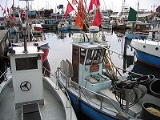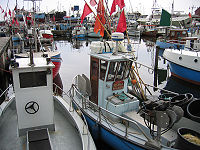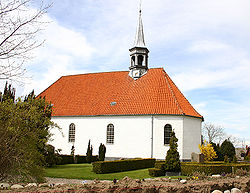
Gilleleje
Encyclopedia
Gilleleje is, with a population of 6,491 (1 January 2011), one of the main towns of the Gribskov municipality
in Region Hovedstaden
in Denmark
. The town is at the northernmost point of Sjælland in Denmark
.
 The name, pronounced ɡiləɑ, is the conjunction of the Danish
The name, pronounced ɡiləɑ, is the conjunction of the Danish
words gil, which is a crevice or cleft and leje, which is a place where fishermen come in specific seasons to fish. It was probably concatenated from Gilbjerg Leje, where Gilbjerg ("cleftmountain") is a rather dramatic name for a rather mundane point just west of town limits. The towns ending in -leje are often from the 16th century, when the fishermen actually settled and regular townships appeared. Compare with the Swedish
ending läge.
 At around this time, it is also known that the town had enough financial means to build a church and hire a priest. This required considerable funds, and the general consensus, then, is that the town went from seasonal fishing to year round fishing, and the fishermen settled down in the years surrounding 1500. Town hall has established 1488 as the "official" founding year to make celebrating easier. The church was inaugurated in 1538 by the newly ordained priest Hans Lauridtzen.
At around this time, it is also known that the town had enough financial means to build a church and hire a priest. This required considerable funds, and the general consensus, then, is that the town went from seasonal fishing to year round fishing, and the fishermen settled down in the years surrounding 1500. Town hall has established 1488 as the "official" founding year to make celebrating easier. The church was inaugurated in 1538 by the newly ordained priest Hans Lauridtzen.
In 1588, the vassal of Kronborg made a list of the taxes that the fishermen should pay. This was one or a half barrel of cod. From this list, we can see who the earliest citizens were. There are about 70 names (a name is analogous to a house - there were probably about 500 citizens), with the surnames Lauritsen, Rasmussen, Jensen and Skomager being the most common. Note that patronymic surnames were the norm then, but from this, it gives an impression of what first names were in vogue among the citizens.
Aside from the fishing, the taxes allowed people to grow various types of crops
south of the town, such as wheat. There was also a pasture, on which there was a many cows and sheeps. Most of the town was on the eastern side of the stream that came from Søborg ("Lakecastle" - ironically, the lake has since been drained and the castle is now a ruin) in the south and went out in the ocean just east of the drying grounds.
Unfortunately, the influx of fishermen made hard on the fishing, and several families could not catch enough fish to both sustain a living and pay the taxes. In 1632, only 18 families were left. This stabilized the conditions somewhat, and in 1682, the number was up to 30, according to the records of Christian V. A new problem was present, though. The shifting sand would bury boats and nets, and had to be shoveled away, delaying the real work somewhat. Part of the eastern side of the town was even deserted as a few houses had gradually been buried under dunes.
South of the town was Nellerupgård, the local manor, home to Carl Christian Lembach and Catrine Marie Milan (a descendant of Gabriel Milan
) in the late 18th century. They owned most of the land in the area, especially after extracting "their" parts of the common pasture, letting the common citizens get the furthermost areas.
During the 1810s and 20s, the city expanded a lot, and many new houses were built in the eastern area that had once been abandoned. A real harbor was built in 1873, where the drying ground had been. This meant larger ships and thus more jobs, making more people move to the town. In 1890, the town was at 865 households, 112 of which were fishermen.
The outer harbor was finished in 1902, and Gilleleje continued to thrive on its fishing until 1941 when the Germans occupied Denmark
. Like most other Danes at the time
, the Gillelejere were against the oppression and helped the Jews by hiding them various places in the town. However, on October 2, 1943, the Gestapo
set out to capture all Danish Jews. The Jews in Gilleleje were hid on the church-loft, and the fishermen prepared for taking them across the sound to Sweden
in their cutters. They could not leave immediately, though, because of the German patrols in the street. After several days of hiding, an informer let the Germans know where the roughly 75 Jews were hiding, and they were all captured, bar a single boy who hid behind a gravestone in the cemetery. According to local lore, the priest was so mortified by the situation that he never really became normal again.
After the occupation was over, several memorials have been put up in the town, both commemorating the Jews and the fishermen who lost their lives when colliding with seamines.
The eastern areas (called Stæremosen - "Starling moor") that had been used for pasture became the industrial area in and around 1950, creating more jobs, meaning more newcomers. The harbor is the 5th largest commercial fishing harbor in Denmark
.
Gribskov municipality
Gribskov Kommune is a municipality in Region Hovedstaden . The municipality covers an area of 278 km², and has a total population of 40,512 ....
in Region Hovedstaden
Region Hovedstaden
The Capital Region of Denmark is an administrative region of Denmark established on January 1, 2007 as part of the 2007 Danish Municipal Reform, which replaced the traditional counties with five larger regions. At the same time, smaller municipalities were merged into larger units, cutting the...
in Denmark
Denmark
Denmark is a Scandinavian country in Northern Europe. The countries of Denmark and Greenland, as well as the Faroe Islands, constitute the Kingdom of Denmark . It is the southernmost of the Nordic countries, southwest of Sweden and south of Norway, and bordered to the south by Germany. Denmark...
. The town is at the northernmost point of Sjælland in Denmark
Denmark
Denmark is a Scandinavian country in Northern Europe. The countries of Denmark and Greenland, as well as the Faroe Islands, constitute the Kingdom of Denmark . It is the southernmost of the Nordic countries, southwest of Sweden and south of Norway, and bordered to the south by Germany. Denmark...
.
Etymology

Danish language
Danish is a North Germanic language spoken by around six million people, principally in the country of Denmark. It is also spoken by 50,000 Germans of Danish ethnicity in the northern parts of Schleswig-Holstein, Germany, where it holds the status of minority language...
words gil, which is a crevice or cleft and leje, which is a place where fishermen come in specific seasons to fish. It was probably concatenated from Gilbjerg Leje, where Gilbjerg ("cleftmountain") is a rather dramatic name for a rather mundane point just west of town limits. The towns ending in -leje are often from the 16th century, when the fishermen actually settled and regular townships appeared. Compare with the Swedish
Swedish language
Swedish is a North Germanic language, spoken by approximately 10 million people, predominantly in Sweden and parts of Finland, especially along its coast and on the Åland islands. It is largely mutually intelligible with Norwegian and Danish...
ending läge.
History
The earliest confirmed permanent residence in Gyldeleye (earlier spelling) is in the early 16th century. An excavation, done in 1979 by the city museum, revealed a lot from a house under the layers of sand. The house had most likely been built shortly after 1536, as a coin was found, dated 1534-36. There were also found ceramics reminiscent of other finds, so the archeologists assumed that the culture layer was from the late 15th century. Additionally, the house was found on the address Fabersvej 10 which is not the closest to the beach, and the habit was to build from the beach and inwards.
In 1588, the vassal of Kronborg made a list of the taxes that the fishermen should pay. This was one or a half barrel of cod. From this list, we can see who the earliest citizens were. There are about 70 names (a name is analogous to a house - there were probably about 500 citizens), with the surnames Lauritsen, Rasmussen, Jensen and Skomager being the most common. Note that patronymic surnames were the norm then, but from this, it gives an impression of what first names were in vogue among the citizens.
Aside from the fishing, the taxes allowed people to grow various types of crops
south of the town, such as wheat. There was also a pasture, on which there was a many cows and sheeps. Most of the town was on the eastern side of the stream that came from Søborg ("Lakecastle" - ironically, the lake has since been drained and the castle is now a ruin) in the south and went out in the ocean just east of the drying grounds.
Unfortunately, the influx of fishermen made hard on the fishing, and several families could not catch enough fish to both sustain a living and pay the taxes. In 1632, only 18 families were left. This stabilized the conditions somewhat, and in 1682, the number was up to 30, according to the records of Christian V. A new problem was present, though. The shifting sand would bury boats and nets, and had to be shoveled away, delaying the real work somewhat. Part of the eastern side of the town was even deserted as a few houses had gradually been buried under dunes.
South of the town was Nellerupgård, the local manor, home to Carl Christian Lembach and Catrine Marie Milan (a descendant of Gabriel Milan
Gabriel Milan
Gabriel Milan was Jewish governor of the Danish West Indies from 7 May 1684 to 27 February 1686. Though he mainly went by the name of 'Gabriel Milan', he identified himself as Don Franco de Tebary Cordova in his correspondence with King Frederick III of Denmark...
) in the late 18th century. They owned most of the land in the area, especially after extracting "their" parts of the common pasture, letting the common citizens get the furthermost areas.
During the 1810s and 20s, the city expanded a lot, and many new houses were built in the eastern area that had once been abandoned. A real harbor was built in 1873, where the drying ground had been. This meant larger ships and thus more jobs, making more people move to the town. In 1890, the town was at 865 households, 112 of which were fishermen.
The outer harbor was finished in 1902, and Gilleleje continued to thrive on its fishing until 1941 when the Germans occupied Denmark
Occupation of Denmark
Nazi Germany's occupation of Denmark began with Operation Weserübung on 9 April 1940, and lasted until German forces withdrew at the end of World War II following their surrender to the Allies on 5 May 1945. Contrary to the situation in other countries under German occupation, most Danish...
. Like most other Danes at the time
Rescue of the Danish Jews
The rescue of the Danish Jews occurred during Nazi Germany's occupation of Denmark during World War II. On October 1st 1943 Nazi leader Adolf Hitler ordered Danish Jews to be arrested and deported...
, the Gillelejere were against the oppression and helped the Jews by hiding them various places in the town. However, on October 2, 1943, the Gestapo
Gestapo
The Gestapo was the official secret police of Nazi Germany. Beginning on 20 April 1934, it was under the administration of the SS leader Heinrich Himmler in his position as Chief of German Police...
set out to capture all Danish Jews. The Jews in Gilleleje were hid on the church-loft, and the fishermen prepared for taking them across the sound to Sweden
Sweden
Sweden , officially the Kingdom of Sweden , is a Nordic country on the Scandinavian Peninsula in Northern Europe. Sweden borders with Norway and Finland and is connected to Denmark by a bridge-tunnel across the Öresund....
in their cutters. They could not leave immediately, though, because of the German patrols in the street. After several days of hiding, an informer let the Germans know where the roughly 75 Jews were hiding, and they were all captured, bar a single boy who hid behind a gravestone in the cemetery. According to local lore, the priest was so mortified by the situation that he never really became normal again.
After the occupation was over, several memorials have been put up in the town, both commemorating the Jews and the fishermen who lost their lives when colliding with seamines.
The eastern areas (called Stæremosen - "Starling moor") that had been used for pasture became the industrial area in and around 1950, creating more jobs, meaning more newcomers. The harbor is the 5th largest commercial fishing harbor in Denmark
Denmark
Denmark is a Scandinavian country in Northern Europe. The countries of Denmark and Greenland, as well as the Faroe Islands, constitute the Kingdom of Denmark . It is the southernmost of the Nordic countries, southwest of Sweden and south of Norway, and bordered to the south by Germany. Denmark...
.

